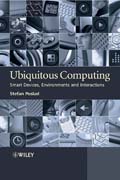
The term Ubiquitous computing is attributed to Mark Weiser in a Scientific American article he wrote in 1991. Weisers vision focuses on a digital technology that is interactive, non-obtrusive and pervasive. His concern was that interfaces are too demanding of human attention. The increasing availability of smaller and smarter digital technology gives us useful access to invoke and receive services, anywhere and anytime. The concept of ubiquitous computing is human-centred - it centres on technology becoming invisible to, but yet readily accessible to humans. The book is partitioned into 3 sections: introduction, ubiquitous computing and ubiquitous intelligence. 1) Introduction: after describing the vision, challenges and some illustrative examples, this section describes the essential parts of this ubiquitous vision: a wireless (and wired) network infrastructure, computer services constructed so that they are available everywhere and human computer interface design to support the feature of being invisible. This part concludes by describing the rich functionality, complexityand intelligence, ubiquitous computing needs to offer. 2) Ubiquitous computing focuses on how we design and implement devices and environments: to support user and object mobility, aggregation and to context (such as location) awareness and adaptation to make service access more invisible to the users. 3) Ubiquitous intelligence covers designing and implementing features of intelligenceto support ubiquitous computing. A key issue is whether to make the devices smart, the environment smart or both.
- ISBN: 978-0-470-03560-3
- Editorial: John Wiley & Sons
- Encuadernacion: Cartoné
- Páginas: 502
- Fecha Publicación: 27/03/2009
- Nº Volúmenes: 1
- Idioma: Inglés
